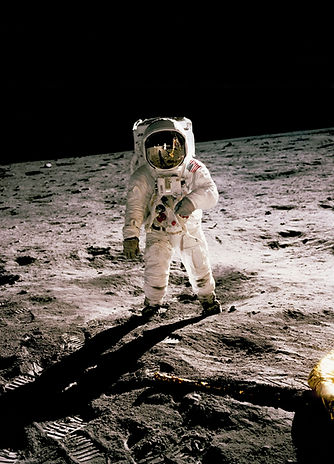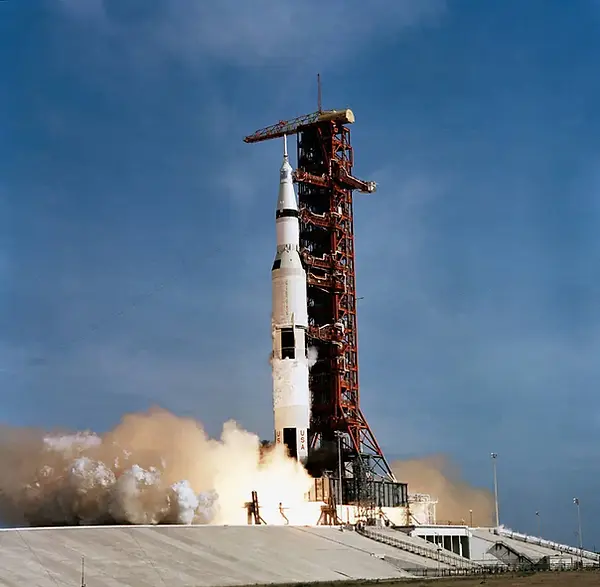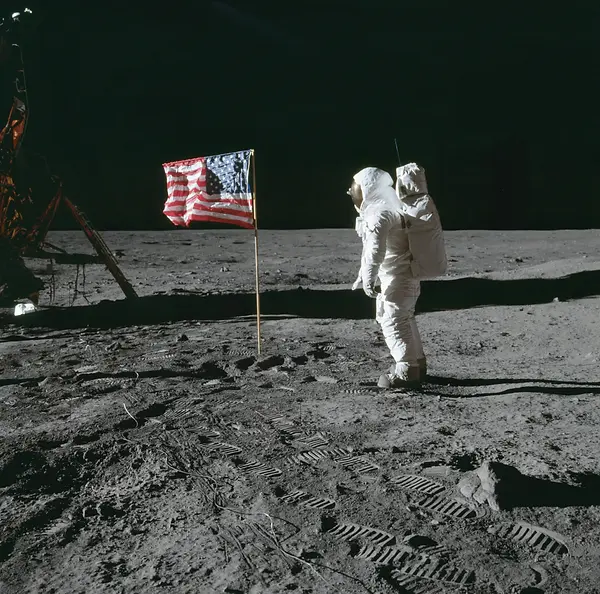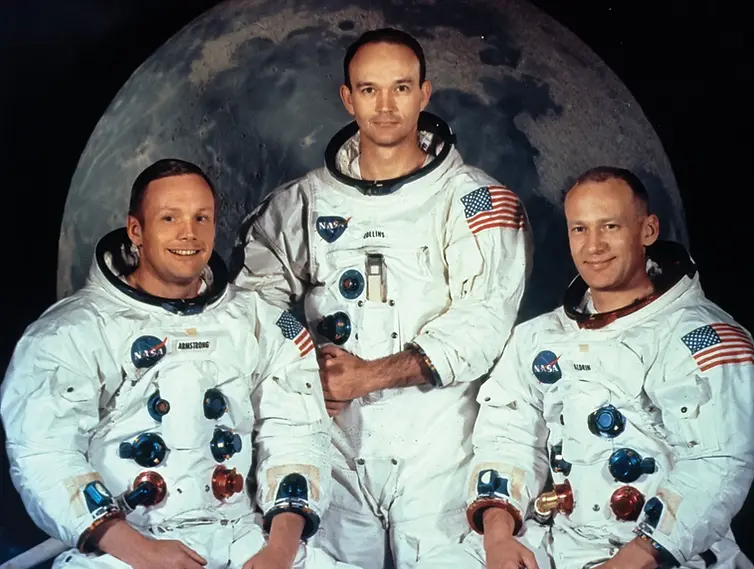FAKE
MOON
LANDING

Introduction

The Apollo 11 mission achieved what most thought impossible, sending a human to the moon on July 20, 1969 (NASA). John F. Kennedy set a primary goal during the 20th century to perform a “crewed lunar landing and return to Earth” mission (NASA). His goal was met, and the history of mankind has been changed, but with the rampant advancement of technology in the 21st century, many have turned to believe the moon landing was faked because of the inconsistencies of old video footage. Many conspiracy theories sparked the interest in a fake moon landing created by NASA to win the space race against the Soviet Union in 1969 (NASA). Was NASA’s Apollo 11 mission faked?



Character Analysis
One of the few who walked on the moon, Neil Armstrong, became a national US figure from his impossible achievements. But his achievements did not define him, He was a man of humility and bravery. He demonstrated both traits through his dangerous trip to the moon. When Neil Armstrong was assigned as the captain of Apollo 11, he kept everyone calm and united everyone to achieve the dream: landing on the moon (Neil Armstrong). His most important quote is “One small step for a man, one giant leap for mankind,” which became one of humanity's iconic symbols as he became the first human to ever step foot on the moon (Neil Armstrong). Neil’s first step on the moon shows his character as a man with courage and bravery, but also what it means to be a hero.
Neil Armstrong’s bravery was shown by his dangerous trip to the moon. Back then, no one had any idea if it was possible to send a human to outer space and onto the moon; many problems arose during the journey (Wall). Many of these problems included the moon’s lumpy surface, the entrance to the moon’s orbit, and the intense pressure placed on the astronauts to land on the moon (Wall). Despite the numerous problems, Neil Armstrong held firm with ironclad bravery and successfully guided the team to land on the moon. He demonstrated courage through conquering obstacles while under pressure.
Neil Armstrong showed humility both in his words and actions. When he was asked by a reporter, “As far as responsibilities of representing mankind on this trip,” He would size down the question and transform it into a collective effort of NASA’s team, “It’s a job that we collectively said was possible, that we could do, and of course the nation itself is backing us, so we just sincerely hope that we measure up to that” (How Neil Armstrong Stayed Humble). Neil Armstrong credits the NASA team behind the moon landing project for them, “We’d like to give a special thanks to all those Americans who built the spacecraft, who did this construction, design, the tests, and put their heart and all their abilities into the spacecraft” (How Neil Armstrong Stayed Humble). Even after achieving extreme fame, he would lead a quiet life and earn the reputation, “an inscrutable loner” (Gutterman). By rejecting the celebrity status, crediting others, and leading a quiet life, Armstrong showed humility through his words, actions, and lifestyle.
Neil Armstrong's legacy changed the course of history as the commander of the Apollo 11 mission on June 19, 1969 (One Small Step). He landed humanity on another celestial body for the very first time and fulfilled President John F. Kennedy’s goal of “landing humans on the Moon by the end of the decade and returning them safely to Earth” (One Small Step). With his foot stepping into the history book, forever landing himself as someone who achieved the impossible, his legacy persisted throughout history as a man with a dream that can reach the stars.
Neil Armstrong’s defining traits, humility and bravery, were etched into history during the Apollo 11 mission. From the liftoff to the first steps on the moon, he did the impossible and redefined what mankind can achieve (Neil Armstrong). Even as millions of Americans were watching him, he proceeded with his mission and united citizens together and acknowledging the NASA team for this opportunity (Gutterman). Armstrong’s legacy is not about when he was at his highest; it was when he showed his true character and lifted himself and others to new heights.


Conspirarcy Theories
On July 20th, 1969, NASA achieved the impossible: landing on the moon first (“Apollo 11 Mission). Yet decades later, in the 21st century, many conspiracy theorists doubted the NASA moon landing (The Guardian News & Media). Three conspiracy theories became prevalent in the discussion of the truth of the moon landing. The first two theories involved why certain elements of the moon’s shadows and wind conditions were distorted, while the last involved NASA itself. These theories were entirely based on misinformation, assumptions, and a lack of scientific evidence (Royal Museums Greenwich).
The first theory focused on the night sky; the astronauts filmed themselves in the night sky. Why are there no stars in the sky on the moon? (Constantine). The sky was engulfed in pitch blackness with no stars in sight. This was due to the camera's shutter speed (1/250 of a second) (Royal Museums Greenwich). The space photographer Mark Constantine explains, “this speed was necessary to avoid overexposure of the brightness of the lunar surface, and the moon did not have an atmosphere” (Constantine). The sunlight had no filtration and became the dominant source of light in the Apollo photos by Neil Armstrong (Constantine). Because of this, NASA chose this camera at this set speed to prioritize capturing the landscape and not the sky, and debunks the theory entirely.
The second major theory was highly debated because of how the flag was presented: “The Apollo 11 US flag is waving in the wind… but there’s no wind on the Moon” (Royal Museums Greenwich). In the famous photo, “Buzz Aldrin salutes the US flag during the Apollo 11 Moon landing”, the flag is seen with wrinkles and seems to be blown by the wind (NASA). This was mainly due to it being a still photo, not a video. The flag has been “screwed up for four days en route to the Moon” and “a telescopic pole has been extended along the top in order to make the flag fly proudly (Royal Museums Greenrich). Since the flag was taken as a picture instead of a video, NASA could not show the stillness of the flag on the moon in the vacuum of space. With this misinterpretation, the conspiracy theory was formed because of the skepticism of the moon landing, and has been proven false.
The third theory, the most talked about, became the most prominent conspiracy theory of the three. “If we went to the Moon in 1969, why have we never been back?” Conspiracy theorists questioned the 50-year gap since the last moon landing as evidence that the moon landing was faked (National Air and Space Museum). After the last human was sent to the moon in 1972, NASA deleted Apollo 18 and 19 to save money for other projects. As the National Air and Space Museum explains, “The Vietnam War became the main priority of the US and cut NASA’s budget in 1967,” which led to poverty, urban problems, and environmental crises, making the space program less of a priority. (National Air and Space Museum). All these factors prohibited NASA from creating another rocket ship to the moon. With the lower budget being less of a priority by the Congress and government, NASA has never returned to the moon since 1972. This conspiracy theory has been debunked, and NASA could not return due to geopolitical reasons.
With the numerous amounts of theories surrounding NASA’s moon landing, the three most talked about are the absence of stars in the photos, the flag being blown by the wind in outer space, and NASA not returning to the moon. These three theories all fall under scrutiny. The pitch black sky in the moon landing photo isn’t present because the camera was optimized to capture the moon’s surface. The US flag was simply wrinkled from being screwed inside the telescopic pole and is taken as a still photo, not a video. NASA never returned back because the government’s priority shifted towards the economic state of America. The reality is that these theories all stemmed from misinformation, assumptions, and a lack of scientific evidence to disprove the moon landing.
Conclusion
NASA’s Apollo 11 mission was successfully launched in 1969. Many conspiracy theorists believed the fake moon landing was faked because of how ancient technology was back then (Royal Museums Greenwich). Was the moon landing faked? Why did they never return? Many theories arose from the inconsistencies of many things in videos and photographs of the lunar surface. The conspiracy theories rose from misinformation, assumptions, and a lack of scientific evidence.

Work Cited
Constantine, Mark. “Why Are There No Stars in Apollo Photos?” Moonpans, 2015,
Gutterman, Andrew. “How the First Man on the Moon Kept His Feet on the Ground.” Time, 10
Oct. 2018, https://www.seattletimes.com/opinion/how-neil-armstrong-stayed-humble/
“How Neil Armstrong Stayed Humble.” The Seattle Times, 20 Oct. 2012,
https://www.seattletimes.com/opinion/how-neil-armstrong-stayed-humble/
National Air and Space Museum. "Why 50 Years Since Humans Went to the Moon?"
Smithsonian Institution, 13 Dec. 2022,
airandspace.si.edu/stories/editorial/why-50-years-since-humans-went-moon.
NASA. Apollo 11 Mission Overview. NASA, 15 Apr. 2021, www.nasa.gov/mission/apollo-11/. Accessed 9 April 2025.
“Neil Armstrong.” Encyclopedia Britannica, Inc., 4 Apr. 2025,
https://www.britannica.com/biography/Neil-Armstrong
One Small Step: The Legacy of Neil Armstrong.” NASA, NASA, July 10, 2010,
https://www.nasa.gov/image-article/one-small-step-legacy-of-neil-armstrong/
Royal Museums Greenwich. "Moon Landing Conspiracy Theories Debunked." Royal Museums Greenwich, www.rmg.co.uk/stories/topics/moon-landing-conspiracy-theories-debunked. Accessed 9 April 2025.
The Guardian News & Media. “One Giant Lie: Why So Many People Still Think the Moon Landings Were Fakes.” The Guardian, 10 July 2019, https://www.theguardian.com/science/2019/jul/10/one-giant-lie-why-so-many-people-still-think-the-moon-landings-were-faked
Wall, Milk. “Apollo 11’s Risky Moon Landing Included ‘Lots of Little Failures.” Space.com,
Future US, Inc., 20 July. 2019, https://www.space.com/apollo-11-risky-moon-landing-dangers.html



